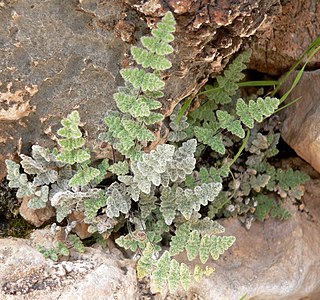
Cheilanthes, commonly known as lip ferns, is a genus of about 180 species of rock-dwelling ferns with a cosmopolitan distribution in warm, dry, rocky regions, often growing in small crevices high up on cliffs. Most are small, sturdy and evergreen. The leaves, often densely covered in trichomes, spring directly from the rootstocks. Many of them are desert ferns, curling up during dry times and reviving with the coming of moisture. At the ends of veins sporangia, or spore-bearing structures, are protected by leaf margins, which curl over them.
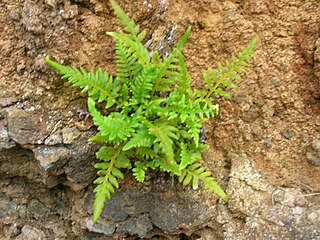
Pteridaceae is a family of ferns in the order Polypodiales, including some 1150 known species in ca 45 genera, divided over five subfamilies. The family includes four groups of genera that are sometimes recognized as separate families: the adiantoid, cheilanthoid, pteridoid, and hemionitidoid ferns. Relationships among these groups remain unclear, and although some recent genetic analyses of the Pteridales suggest that neither the family Pteridaceae nor the major groups within it are all monophyletic, as yet these analyses are insufficiently comprehensive and robust to provide good support for a revision of the order at the family level.
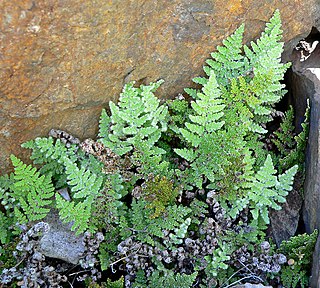
Myriopteris covillei, formerly known as Cheilanthes covillei, is a species of lip fern known by the common name Coville's lip fern.
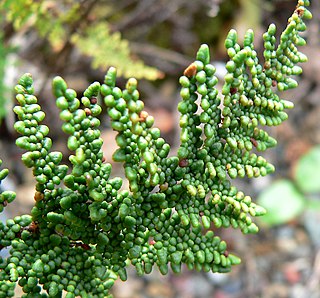
Myriopteris clevelandii, formerly known as Cheilanthes clevelandii, is a species of lip fern known by the common name Cleveland's lip fern.
Myriopteris cooperae, formerly Cheilanthes cooperae, is a species of lip fern known by the common name Mrs. Cooper's lip fern, or simply Cooper's lip fern. The type specimen of this species was collected by Sarah Paxon Cooper and was named in her honor by D. C. Eaton.
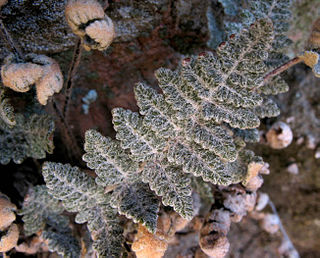
Myriopteris newberryi, formerly Cheilanthes newberryi, is a species of lip fern known by the common name Newberry's lip fern. It is native to southern California and Baja California, where it grows in rocky places in mostly dry habitat such as the California chaparral and woodlands.
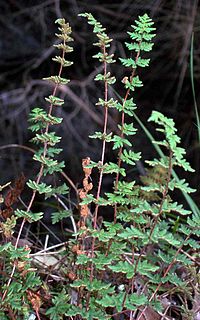
Cheilanthes sieberi is a small fern growing in many parts of Australia, New Zealand and nearby islands. Common names include poison rock fern and mulga fern.

Laguna de Sayula is a lake located in the southern area of Jalisco, about 60 km from Guadalajara. It is located in the municipalities of Sayula, Zacoalco de Torres, Amacueca, Teocuitatlán de Corona, Atoyac and Techaluta de Montenegro.
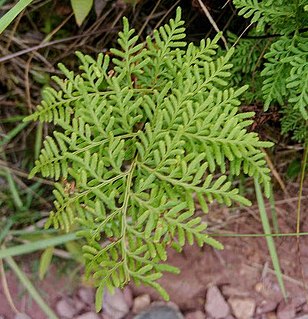
Gaga is a genus of 19 species of ferns in the family Pteridaceae named after American singer and songwriter Lady Gaga. Two of the 19 species are newly-described: Gaga germanotta from Costa Rica, named after the family of the singer, and Gaga monstraparva, in honor of Gaga's fans, whom she calls "little monsters". According to biologists, the ferns bear a close resemblance to Gaga's costume from the 52nd Annual Grammy Awards and also bear a distinct DNA sequence spelling GAGA.

Myriopteris tomentosa, formerly known as Cheilanthes tomentosa, is a perennial fern known as woolly lipfern. Woolly lipfern is native to the southern United States, from Pennsylvania to Arizona and Georgia, and Mexico.
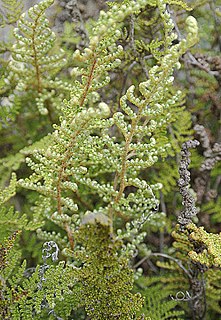
Myriopteris myriophylla, the Central American lace fern, is a species of lip fern. Despite its common name, this species is native as far south as Argentina. It is adapted to dry areas.

Myriopteris lanosa, the hairy lip fern, is a moderately-sized fern of the eastern United States, a member of the family Pteridaceae. Its leaves and stem are sparsely covered in hairs, but lack scales, hence its common name. One of the cheilanthoid ferns, it was usually classified in the genus Cheilanthes until 2013, when the genus Myriopteris was again recognized as separate from Cheilanthes. It typically grows in shallow, dry, soil, often in rocky habitats.

Myriopteris, commonly known as the lip ferns, is a genus of cheilanthoid ferns. Like other cheilanthoids, they are ferns of dry habitats, reproducing both sexually and apogamously. Many species have leaves divided into a large number of small, bead-like segments, the probable inspiration for the generic name. Hairs and/or scales are often present on both the upper and lower surfaces of the leaf, and their presence and appearance are useful in distinguishing between species. The genus is most diverse in Mexico, but species are found from southwestern Canada south to southern Chile, and one species is endemic to southern Africa.

Myriopteris alabamensis, the Alabama lip fern, is a moderately-sized fern of the United States and Mexico, a member of the family Pteridaceae. Unlike many members of its genus, its leaves have a few hairs on upper and lower surfaces, or lack them entirely. One of the cheilanthoid ferns, it was usually classified in the genus Cheilanthes as Cheilanthes alabamensis until 2013, when the genus Myriopteris was again recognized as separate from Cheilanthes. It typically grows in shade on limestone outcrops.
Myriopteris aemula, the Texas lip fern or rival lip fern, is a moderately-sized fern of Texas and Mexico, a member of the family Pteridaceae. Unlike many members of its genus, its leaves have a few hairs on upper and lower surfaces, or lack them entirely. One of the cheilanthoid ferns, it was usually classified in the genus Cheilanthes as Cheilanthes aemula until 2013, when the genus Myriopteris was again recognized as separate from Cheilanthes. It typically grows on limestone rock.
Myriopteris allosuroides is a moderately-sized fern of Mexico, a member of the family Pteridaceae. Unlike many members of its genus, its rachides are grooved on the upper surface and largely free of hairs or scales. One of the cheilanthoid ferns, it was usually classified in the genera Cheilanthes or Pellaea until 2013, when the genus Myriopteris was again recognized as separate from Cheilanthes. It typically grows on dry, rocky slopes over acidic, particularly basaltic, rock.

Myriopteris aurea, the golden lip fern or Bonaire lip fern, is a moderately-sized fern native to the Americas, a member of the family Pteridaceae. Unlike many members of its genus, its leaf is only modestly dissected into lobed leaflets (pinnae), which are hairy both above and below. One of the cheilanthoid ferns, it was usually classified in the genera Cheilanthes as Cheilanthes bonariensis until 2013, when the genus Myriopteris was again recognized as separate from Cheilanthes. It typically grows on dry, rocky slopes, and ranges from Mexico, where it is extremely common and widespread, and the southwestern United States south and east through Central and South America as far as Chile and Argentina.
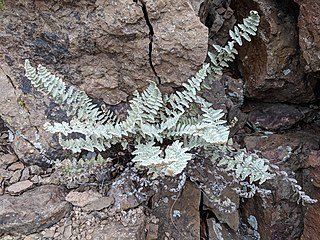
Myriopteris rufa, commonly known as Eaton's lip fern, is a moderately-sized fern of Mexico and the southwestern United States, with outlying populations in Costa Rica and the Appalachian Mountains. One of the cheilanthoid ferns, it was usually classified in the genus Cheilanthes, as Cheilanthes eatonii, until 2013, when the genus Myriopteris was again recognized as separate from Cheilanthes. It typically grows in rocky habitats, most frequently on limestone but also sometimes on basalt or shale.

Myriopteris rawsonii, formerly known as Cheilanthes rawsonii, is a perennial fern native to Namaqualand.

















